Hidden in Plain Site
Co-curated by Litza Jansz and Veronica Slater
Dr Cherry Smyth is a poet and art writer. She is an Associate Professor of Creative and Critical Writing at University of Greenwich. She writes for magazines including Art Monthly.
Introduction
'Take this house from my body, brick from my bones. There's my foot under yours. Take it. It will make you rich. Wrap me in your heroic sheet. Cover your face, I'm decomposed.' (1)
For many, 2020-2021 has given us intense training in looking at, as well as ignoring what lies hidden in plain sight. Factors of social injustice have been thrown into painfully sharp relief by the pandemic, only to subside in the lens of the media and social media to background interference. A Bradford councillor calls the unforeseen levels of poverty and emboldened racism the result of A,B,C & D: Austerity, Brexit, Covid and Discrimination. Yet the Tories reacted to the outcry of the Black Lives Matter movement with an attempt to ban teaching 'critical race studies' in universities, lest white people too awaken to their role not only in white supremacy, but also in capitalism, patriarchy and class systems of power and privilege. In this timely show, Veronica Slater and Litza Jansz, demonstrate how art can and must intervene in the Neo-liberal cover-ups, which built an exploitative empire on the idea of 'nothing to see here'; in the life-threatening aestheticisation and ruthless eradication of local working class communities; and in the domestic traumas that make the family home unsafe and abuse unsaid. 'Hidden in Plain Site' presents painting, animation, film and sculpture to make things that matter present, plain and sighted.
(1) Leeanne Quinn, (2012) 'Rubble' from Before You. Dublin: Dedalus Press
John Smith
John Smith's beautiful elegy for East London homes destroyed to build the M11 link road, 'Blight', 1994-96, interweaves voices of the evicted and demolition footage to a dramatic score by Jocelyn Pook. Masterful editing introduces warning flash frames of red, green and blue to the thud of bricks, which mount to streaks of colour as figurative details of domestic life are subsumed by mechanistic force. Smith lets graffiti on the remnant homes narrate the protest, leaving us haunted by one resident's voice: 'It has a living energy of itself. That house has a spirit – sorry….'. 'Blight' reverberates now as a plangent plea to stop destroying our planet home and to design more earth-centred dialogue between architecture, infrastructure and community, beyond our speed and growth dependency.
'The Black Tower', 1985-87, is a compelling portrait of a man's descent into paranoia and death. The narrator notices a squat black tower on a plinth that seems to track him through the London streets and appears like a black hole in the sky. No one knows its function or seems to care. It stands increasingly for the menace of anonymous surveillance apparatus that eventually threatens our autonomous movement. The film has become more prescient in times of vast data storage and AI, these blank, faceless systems that abstract information from our living, feeling bodies and render us alienated and dehumanised.
johnsmithfilms.com
Litza Jansz and Esther Neslen
Urgent concerns about what words like 'local' and 'community' mean are delicately handled in Litza Jansz and Esther Neslen's film 'We are Moving', (2018). Made with Walthamstow residents who drew and painted on projected footage of their local high street, this short animation centres around its title's pun: shops are closing and people are walking down the increasingly vacant street. Some are followed by an aura of marks like traces of smoke, music or laughter; while others move along in a self-contained box; some come in a moody smudge, others dabbed with colour, thus delivering characters with vivid connections to each other and to place.
estherneslen.co.uk
Dr Chila Kumari Singh Burman
In her brilliant installation of a city skyline, Chila Burman evokes Las Vegas, the hyperbolic city of American dreams and high-risk living, transposed to a city in the north of England where the artist once helped in the family ice cream business. 'Cornets and Screwballs Go Vegas', 2019-20 wittily unites this symbol of aspiration and excess with the stacked, brightly coloured ice-cream cones, which react valiantly against the bland beige of wafer and the dominant off-white skin tone in the UK. The vibrant and vital castle of 'Cornets and Screwballs Go Vegas' stands as an anti-assimilationist triumph, while the name suggests that Asians have also found a language in which to thrive.
In 'Spooning', 2022, small plastic spoons, usually discarded, mass produced and massively unfriendly to the environment, are recycled and regaled as precious objects, adorned with bindis, costume jewels, lipstick and paint. While spooning is a gesture of intimacy, through this installation, Burman claims the intimacy on her own terms, inserting her cultural aesthetic into the mainstream, honouring something that is dismissed as worthless after use: the experience of many immigrants. With resistant humour and embodiment, Burman pushes her cultural legacy, that is commonly made to disappear, to the foreground.
www.chila-kumari-burman.co.uk
Veronica Slater
If décor is the skin of a house, Veronica Slater's new series thisHOUSE? peels it back to go beneath to the bricks and mortar of what we house and what houses us. If the house is the self, what happens when the house is broken into and that core image of refuge perturbed? Slater's paintings play out the dichotomies of pattern and place, of the ideal and its fracture in powerful works that also resonate with themes of artifice and nature, of the synthetic and the organic. The line between what is remembered and what supressed is crossed and re-crossed through the gestures of painting, that move nimbly between representation and abstraction, suggesting, as Gaston Bachelard argues, that, 'Not only our memories, but the things we have forgotten are "housed". Our soul is an abode. And by remembering "houses" and "rooms", we learn to abide within ourselves. Now everything becomes the house in both directions: they are in us as much as we are in them.' (2) The image of the house finally tumbles and spins, until it floats beyond the civilising and containing elements of the decorative into a pixelated universe of dreamy resolution.
(2) Gaston Bachelard, (1994) The Poetics of Space. Boston: Beacon Press, p.xxxvii
www.veronicaslater.com
Litza Jansz
In 'Tide', (2019) by Litza Jansz, a woman alone, naked, on a beach, sits separately from the cries of families at play and chooses a way to vanish. Is this an end or a renewal in another dimension? Figures of diverse age, race and gender await your interaction in 'The Elephant is the room', (revised 2021). The problem that we refuse to acknowledge, Litza Jansz suggests, is that the family's domestic and psychic space we have inherited often entraps and limits us, demanding particular and stagnant role-playing. The nuclear family is clearly an idealised fiction but is still promoted and celebrated as the social and successful norm. Jansz provides the props to invite us to design a new configuration that could make visible the emotional freight that has been overlooked, unspoken. Many of us grew up with the family motto, which Audre Lorde's family used to survive racial discrimination: 'We could conquer it by ignoring it.' (3)
(3) Audre Lorde, (1990) Zami: a new spelling of my name. London: Sheba Feminist Publishers, p.81
litzajansz.co.uk
Mandy Eugeniou
Mandy Eugeniou's 'The Black Tower', 2019, a homage to John Smith's work of the same name, mimics the low-key narrator who presents the everyday as evidence of the extraordinary. The incidental tone builds to an increasing sense of bewilderment as the narrator keeps noticing the burnt shell of Grenfell Tower in different locations without knowing what it is. 'Was the design some kind of monument?' she asks. Colourful split screens and scratched celluloid effects convey the narrator's perception becoming more unhinged by being the only one who notices the 'cube-like structure.' We see her flicking through images of tall buildings on an iPad for information, as if a high-rise can only exist if it has been photographed. This is rendered even more cogent by the fact that the images of Grenfell came from the general public after a call out for images. Eugeniou asks in an essay accompanying the film online, how we perpetuate the life of the digital image, especially when it embodies such trauma. Her concerns with how Grenfell is captured and how its image and aftermath captures us are investigated in a subtle and accumulatively involving way. Through projecting the film on various outdoor locations, the artist moves the tragedy from representational to performative memory. Thus she posits a form of counter-memorial aesthetics, which begins to establish what Toni Morrison calls 'the moral imagination.' (4)
(4) Toni Morrison, (2019) Mouth Full of Blood. New York: Chatto & Windus, p.ix
www.theblacktower.co.uk
|
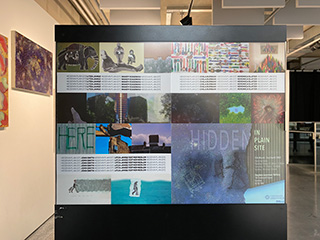
Installation view
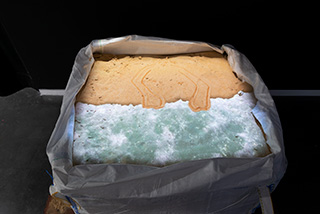
Litza Janz, 'Tide'
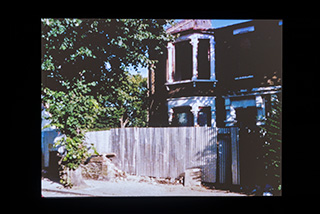
John Smith, 'Blight'
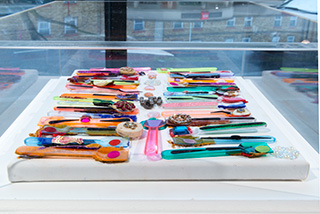
Chila Kumari Burman, 'Spooning'
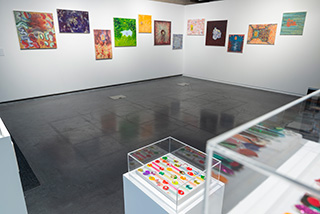
Installation view
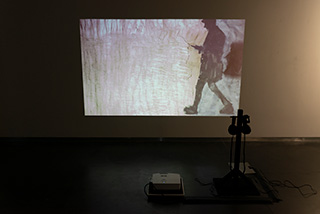
Litza Jansz & Esther Neslen, 'We are moving'
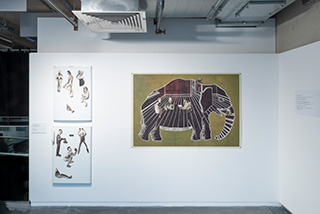
Litza Jansz, 'The Elephant is the room'
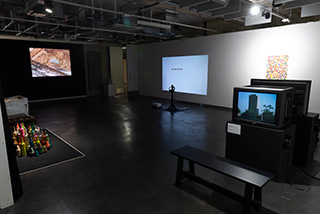
Installation view
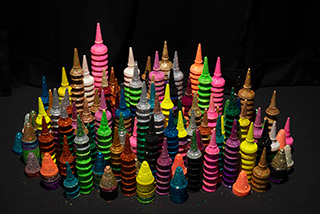
Chila Kumari Burman, 'Cornets & Screwballs go Vegas'
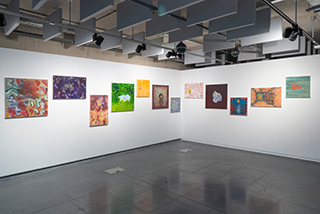
Veronica Slater, 'thisHouse'
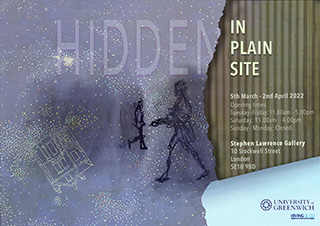
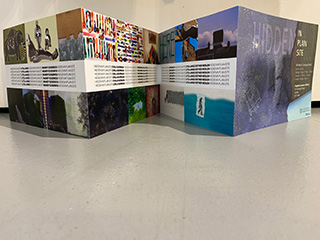
Brochure
|